Spirit of the Dead Watching
Spirit of the Dead Watching (Manao tupapau) is an 1892 oil on burlap canvas painting by Paul Gauguin, depicting a naked Tahitian girl lying on her stomach. An old woman is seated behind her. Gauguin said the title may refer to either the girl imagining the ghost, or the ghost imagining her.[1][lower-alpha 1]
Subject
The subject of the painting is Gauguin's young native wife Teha'amana (called Tehura in his letters), who one night, according to Gauguin, was lying in fear when he arrived home late: "immobile, naked, lying face downward on the bed with the eyes inordinately large with fear . . . Might she not with her frightened face take me for one of the demons and spectres of the Tupapaus, with which the legends of her race people sleepless nights?"[3] The spirit she fears is personified by the old woman seated at left.
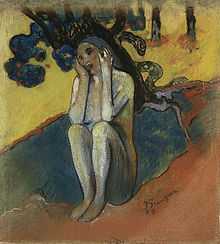
Art historian Nancy Mowll Mathews says the painting is a direct descendent of a previous series of "frightened Eves" that Gauguin painted from 1889.[4] His 1889 Breton Eve, shown at the Volpini exhibition of 1889, represented Eve as in fear of the snake, reinterpreting the traditional Christian theme of innocence before the fall.[5] In his letter of 8 December 1892 to his wife Mette (famously neglecting to mention that the girl in question was his lover),[6] he says "I painted a nude of a young girl. In this position she is on the verge of being indecent. But I want it that way: the lines and movement are interesting to me. And so, I give her, in depicting the head, a bit of a fright." He then needed to find a pretext for the girl's emotions.[4] Mathews says it is too simple to attribute Tehura's terror to her belief in spirits and irrational fear of the dark; she says, following Sweetman,[7] that Gauguin's sexual predilections should not be ignored when trying to understand the work. Rather, she suggests the girl's fear was a response to Gauguin's aggressive behavior, consistent with his known battering( says Mathews) of his wife Mette, the submissive fear in her eyes his erotic reward.[8][9]
Other historians such as Naomi E. Maurer have viewed the narrative as a device to make the indecency of the subject more acceptable to a European audience.[10]
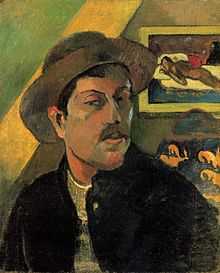
The painting appears (as a mirror image) in the background of another Gauguin painting, his Self-portrait with Hat, indicating the importance he attached to it.
Commentary by Gauguin
There are five sources for Gauguin's description of the painting: a letter to his patron Daniel Monfreid dated 8 December 1892, another letter to his wife Mette the same day, his 1893 manuscript Cahier pour Aline ("Notebook for Aline"), the first unpublished 1893-4 draft of Noa Noa and then finally the published 1901 version prepared together with his collaborator Charles Morice .[11] Richard Field has provided a critical analysis of these sources.[12]
- Letter to Daniel Monfreid
In an 8 December 1892 letter to Daniel Monfreid, Gauguin gives the titles of eight paintings he is sending out for exhibition in Copenhagen.[13] He translates the title Manao tupapau as "Think of the Ghost, or, The Spirits of the Dead are Watching" and goes on to say that he wants to reserve it for a later sale, but will sell for 2,000 francs. He describes the painting as follows (without explaining the subject is a nude):
This picture is for me (excellent). Here is the genesis (for you only). General Harmony. Dark dull violet, dark blue and chrome. 1. The draperies are chrome 2. because this colour suggests night, without explaining it however, and furthermore serves as a happy medium between the yellow orange and the green, completing the harmony. These flowers are also like phosphorescences in the night (in her thoughts). The Kanakas believe that the phosphorous lights seen at night are the souls of the dead.
In short, it is a fine bit of painting, although it is not according to nature.
- Paintings from Gauguin's first Tahitian period selected for his Copenhagen exhibition
-
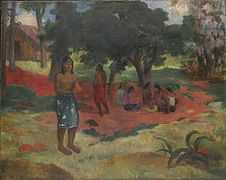
-
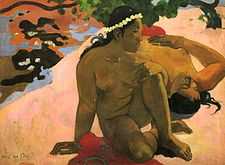
-
-
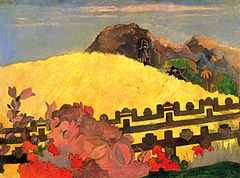
-
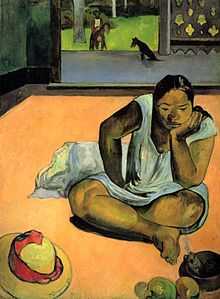
-
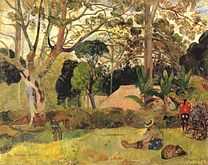
-
_-_Google_Art_Project.jpg)
-

- Letter to Mette Gauguin
In an 8 December 1892 letter to his wife, Gauguin gives translations of the Tahitian titles of the paintings he intends to send. He stresses this is for Mette's eyes only, so that she can provide them for those who ask for them. He fixes a price of at least 1,500 francs for the painting, and goes on to describe it as follows:[14]
I painted a nude of a young girl. In this position she is on the verge of being indecent. But I want it that way: the lines and movement are interesting to me. And so, I give her, in depicting the head, a bit of a fright. It is necessary to justify this fright if not to explain it because it is in the character of a Maori person. Traditionally these people have a great fear of the spirits of the dead. One of our own young girls [in Europe] would be frightened to be caught in this position. (The women here would not.) I have to explain this fright with the least possible literary means as was done formerly. So I did this. General harmony, somber, sad, frightening, telling in the eye like a funeral knell. Violet, somber blue, and orange-yellow. I make the linen greenish-yellow: 1 because the linen of this savage is a different linen than ours (beaten tree bark); 2 because it creates, suggests artificial light (the Kanaka woman never sleeps in darkness) and yet I don't want the effect of a lamp (it is common); 3 this yellow linking the orange-yellow and the blue completes the musical harmony. There are several flowers in the background, but they should not be real, being imaginative, I make them resemble sparks. For the Kanaka, the phosphorescences of the night are from the spirit of the dead, they believe they are there and fear them. Finally, to end, I make the ghost quite simply, a little old woman; because the young girl, unacquainted with the spirits of the French stage, could not visualise death except in the form of a person like herself. There you have the script that will prepare you for the critics when they bombard you with their malicious questions. To conclude, the painting had to made very simple, the motif being savage, childlike [10]
According to Gauguin, the phosphorescences that could be seen in Tahiti at night, and which natives believed to be the exhalations of the spirits of the dead, were emitted by mushrooms that grew on trees.[10] The description of the spirit of the dead that the artist would have been familiar with came from the work of Pierre Loti, who described the spirit as a "blue-faced monster with sharp fangs"; the decision to paint an old woman instead of a bizarre demon may have been prompted by the desire to use a symbol that would be more familiar to a European audience.[15]
- Cahier pour Aline

Gauguin began this notebook in 1893 for his eldest daughter Aline, then sixteen years old, during his first visit to Tahiti.[16] Unfortunately she died in 1897 from pneumonia before she could receive it. The notebook includes a description of the painting, under the title Genèse d'un tableau ("Genesis of a picture"), accompanied by a watercolor sketch.[11] It is here that Gauguin remarked the title Manao tupapau can be understood in two ways:[17]
In this rather daring position, quite naked on a bed, what might a young Kanaka girl be doing? Preparing for love? This is indeed in her character, but it is indecent and I do not want that. Sleeping, after the act of love? But that is still indecent. The only possible thing is fear. What kind of fear? Certainly not the fear of Susannah surprised by the Elders. That does not happen in Oceania. The tupapau is just the thing... According to Tahitian beliefs, the title Manao tupapau has a double meaning... either she thinks of the ghost or the ghost thinks of her. To recapitulate: Musical part - undulating horizontal lines - harmonies in orange and blue linked by yellows and violets, from which they derive. The light and the greenish sparks. Literary part - the spirit of a living girl linked with the spirit of Death. Night and Day. This genèse is written for those who always have to know the whys and wherefores. Otherwise the picture is simply a study of a Polynesian nude.
- Noa Noa

Noa Noa was originally conceived as a travelogue to accompany Gauguin's 1893 Durand-Ruel exhibition. Gauguin wrote the first rough draft (now in the Getty Center) in 1893 but could not complete it in time. He subsequently entered into a collaboration with the Symbolist poet Charles Morice to produce a more elaborate and imaginative work. The manuscript for this, prepared between 1893 and 1897, is now in the Louvre. Extracts, including those dealing with the painting, were published in 1897 in the La Revue Blanche, while the whole work was finally published at Morice's expense, Gauguin having essentially lost interest, in 1901 in the La Plume edition.[18]
In the draft account, Gauguin describes coming home late to find Teha'amana lying on her bed in the dark. This was to be followed by a description of the painting he never inserted. Finally he records Teha'amana chiding Gauguin for leaving her in the dark:[19][20][21]
One day I had to go to Papeete. I had promised to come back that same evening. On the way back the carriage broke down half way: I had to do the rest on foot. It was one in the morning when I got home. Having at that moment very little oil in the house - my stock was to be replenished - the lamp had gone out, and the room was in darkness when I went in. I felt afraid and, more still, mistrustful. Surely the bird has flown. I struck matches and saw on the bed
(Description of the picture Tupapau)
The poor child came to herself again and I did all I could to restore her confidence. 'Never leave me alone again like this without light! What have you been doing in town? - you've been to see women, the kind who go to the market to drink and dance, then give themselves to the officers, to the sailors, to everybody?'
Gauguin's account is considerably extended in the final published version. Critics agree that Morice was responsible for the expansion, albeit with the full support of Gauguin.[22] The description of the painting, previously omitted, now commences:[23][24][25]
Motionless, naked, lying face down on the bed, her eyes immeasurably larger from fear, Tehura looked at me and seemed not to know me. I too was caught for several moments by a strange feelinmg of uncertainty. Tehura's terror was contagious. I had the illusion that a phosphorescent light was streaming from her staring eyes. Never had I seen her so beautiful, so frighteningly beautiful ...
Wadley comments, as essentially does Frèches-Thory, that the painting is an example of the fusion of reality and fiction in Gauguin's mature work.[22][21] The two accounts of Tehura's reaction, that she was haunted by the tupapau, and that she was angrily suspicious Gauguin had been using prostitutes, likewise pose a similar confrontation between fiction and probable fact.[26]
Sources

Two sources have been suggested for the painting.
The narrative may have been inspired by Pierre Loti's novel Madame Chrysanthème, in which the heroine, a geisha girl, is described as being tormented by night frights. The novel was very successful, and influential in shaping the Japonisme movement of the time. It is known that Gauguin read it.[17]
A direct visual inspiration may have come from David Pierre Giottino Humbert de Superville's etching Allegory. Although there is no direct connection for the link, de Superville had been cited by Albert Aurier as one of the forerunners of Symbolist painting and de Superville's book Unconditional Signs in Art (1827–32) was widely known to that group.[11][17]
Other versions
Gauguin reprised the theme in a pastel (from which there are two counterproofs recorded), in a lithograph, and in several woodcuts, one of which is part of the innovative suite of woodcuts he prepared for his travelogue Noa Noa.
- Pastel
The pastel is done on the reverse of a fully worked pastel study of Annah the Javanese . That study has been cut at the head, indicating that the pastel of the reclining nude was executed later and thus showing a date between 1894 and 1895. Richard Brettell notes the androgynous quality of the figure in the pastel.[27]
- Lithograph
This was the only lithograph on stone executed by Gauguin (other 'lithographs' are in fact zincographs, i.e. transferred from zinc plates). It appeared in the 6th issue of L'Estampe originale , a journal devoted to publishing limited editions of contemporary prints.[28][29]
- Woodcuts
Gauguin prepared his suite of ten Noa Noa woodcuts to accompany his travelogue, but they were never published in his lifetime. The 1901 La Plume edition was planned to include them, but Gauguin declined to allow the publishers to print them on smooth paper. These woodcuts were extremely innovative, amounting to a revolution in printmaking.[30] Also notable is the large 1894 woodcut he prepared in Brittany. This has a carving of the face and upper body of the frightened Teha'amana cut into the reverse of the block, one of three scenes cut into the reverse that Gauguin used to make impressions.[31]
-

Reclining Nude, pastel, 1894-95, National Gallery of Art
-
_-_BM_38.386.jpg)
Manao Tupapau (Watched by the Spirits of the Dead), lithograph, 1894, Brooklyn Museum
-
_-_MFA_60.323.jpg)
Manao Tupapau (The Spirit of the Dead Watching), woodcut (Noa Noa suite), 1893-94, Museum of Fine Arts, Boston
-
_-_MFA_54.1607.jpg)
Manao Tupapau (The Spirit of the Dead Watching), woodcut, 1894-95, Museum of Fine Arts, Boston
-
_-_AIC_1950.109.jpg)
Manao Tupapau (Watched by the Spirits of the Dead), woodcut, 1894-95, Art Institute of Chicago
Notes
References and sources
- References
- ↑ Jolly p. 95 per Eisenman p. 129
- ↑ Danielsson (1966) pp. 114-5
- ↑ Jolly p.101 quoting Noa Noa (Louvre manuscript)
- ↑ 4.0 4.1 Mathews, 181
- ↑ Mathhews p. 134
- ↑ Jolly p. 93
- ↑ Sweetman pp.324-30
- ↑ Mathews, 182
- ↑ Hill, Amelia (7 October 2001). "Gauguin's erotic Tahiti idyll exposed as a sham". theguardian.com. The Guardian. Archived from the original on 27 February 2015.
- ↑ 10.0 10.1 10.2 Maurer, 150
- ↑ 11.0 11.1 11.2 Gamboni (2003)
- ↑ Field pp. 108ff.
- ↑ Monfreid letter VI
- ↑ Malingue CXXXIV
- ↑ Maurer, 150-151
- ↑ "Cahier pour Aline" (PDF). bibliotheque-numerique.inha.fr. Bibliothèque de l'Institut National d'Histoire de l'Art.
- ↑ 17.0 17.1 17.2 Frèches-Thory p. 281
- ↑ Wadley pp. 7-9
- ↑ Wadley pp. 37-8
- ↑ Mathews pp. 181-2
- ↑ 21.0 21.1 Frèches-Thory pp. 280
- ↑ 22.0 22.1 Wadley p.79 n. 61
- ↑ La Revue Blanche p. 173
- ↑ Noa Noa pp. 76-8
- ↑ Louvre manuscript p. 109
- ↑ Wadley p. 80 n. 61
- ↑ Brettell p. 309
- ↑ "L'Estampe Originale: A Rare Print Portfolio Now Online". metmuseum.org. Metropolitan Museum of Art.
- ↑ "Manao Tupapau (Elle pense au revenant) : (épreuve a)". bibliotheque-numerique.inha.fr. Institut National de l'Histoire de l'Art.
- ↑ Frèches-Thory p. 317
- ↑ Frèches-Thory p. 345
- Sources
- Danielsson, Bengt (1965). Gauguin in the South Seas. New York: Doubleday and Company.
- Brettell, Richard (1988). "The Return to France". The Art of Paul Gauguin. with Peter Zegers. National Gallery of Art. pp. 308–9. ISBN 0-8212-1723-2. LCCN 88-81005..
- Eisenman, Stephen F. (1997). Gauguin's Skirt. London: Thames and Hudson. ISBN 0-500-01766-2.
- Field, Richard S. (1977). Paul Gauguin:The Paintings of the First Trip to Tahiti. Garland. ASIN B007EU412C.
- Frèches-Thory, Claire (1988). "The First Tahitian Years". The Art of Paul Gauguin. with Peter Zegers. National Gallery of Art. pp. 279–82, 317–29, 345–8. ISBN 0-8212-1723-2. LCCN 88-81005.
- Gamboni, Dario (2003). "Paul Gauguin's Genesis of a Picture: A Painter's Manifesto and Self-Analysis". Nineteenth-Century Art Worldwide 2 (3).
- Gauguin, Paul. The letters of Paul Gauguin to Georges Daniel de Monfreid, translated by Ruth Pielkovo; foreword by Frederick O'Brien. archive.org
- Jolly, Margaret (2000). "Fraying Gauguin’s Skirt: Gender, Race, and Liminality in Polynesia". Pacific Studies 23 (1/2).
- Malingue, Maurice. Paul Gauguin: letters to his wife and friends. Cleveland, 1949. ASIN B000XJHQ0K
- Mathews, Nancy Mowll. Paul Gauguin: an erotic life, 2001. Yale University Press.
- Maurer, Naomi E. The pursuit of spiritual wisdom: the thought and art of Vincent van Gogh and Paul Gauguin, 1998. Fairleigh Dickinson University Press.
- Sweetman, David (1995). Paul Gauguin, A Life. New York City, New York: Simon & Schuster. ISBN 0-684-80941-9.
- Wadley, Nicholas (1985). Noa Noa: Gauguin's Tahiti, London: Phaidon Press. ISBN 0-7148-2375-9.
Further reading
- Thomson, Belinda. (1987) Gauguin. London: Thames & Hudson. ISBN 0500202206
| ||||||||||||||||||||||||||||||||||
External links
- Cahier pour Aline (facsimile)
